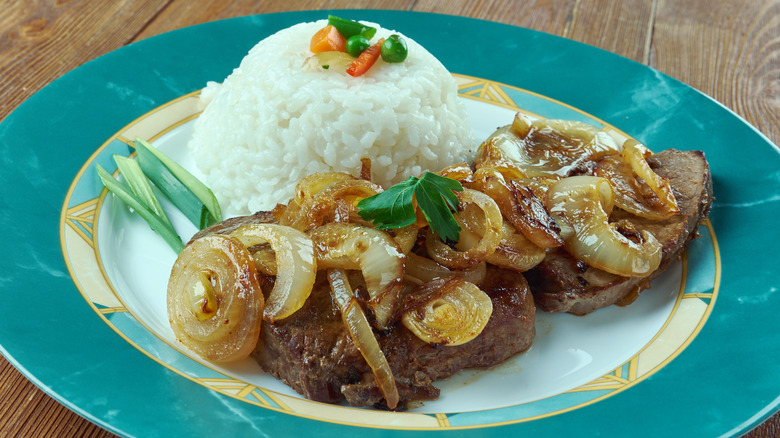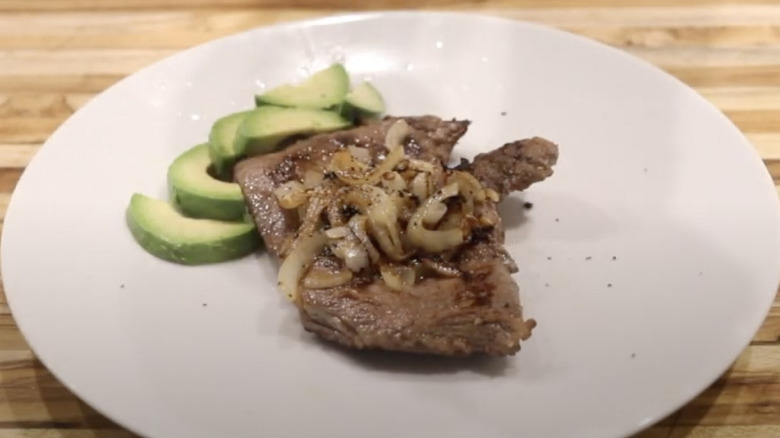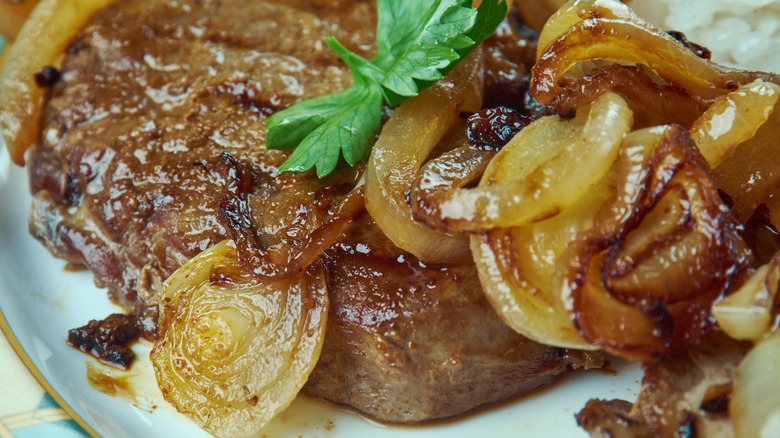Palomilla Steak Is A Thin Serving Of Meat Bursting With Flavor
When the time comes to cook a juicy cut of steak, there are endless methods and styles to choose from. Many different cultures have unique methods for preparing meat beyond simply throwing it on the grill. One such steak is called palomilla steak, aka bistec de palomilla. This type of steak hails from Cuba and translates to "butterflied beefsteak." The meat itself is very thin, only about ¼ inch thick, and it's marinated prior to cooking to ensure the meat absorbs as much flavor as possible.
Traditionally, a sliced top sirloin is used for the dish, as it's a lean, tender cut that cooks quickly when sliced thin. If top sirloin can't be found, top round is also an option. In order to achieve maximum flavor and tenderness, the steak is marinated in lime juice, olive oil, garlic, cumin, and oregano. The lime juice helps break down the meat's fibers, ensuring a tender, juicy bite. Time permitting, the steaks should marinate for several hours, or even overnight. Fortunately, the flavors will still infuse into the meat, even if you only let it sit for a few minutes.
The history of palomilla
People in Cuba have been eating bistec de palomilla for centuries — it's a classic Cuban dish you need to try at least once. Some Cubans can trace their roots back to indigenous Taíno people, who inhabited the island well before the Spaniards arrived in the 1500s. As is the case for many centuries-old cuisines, the exact origins of bistec de palomilla are unknown, though the recipe may have appeared in 16th-century Cuban cookbooks. What is known is that the classic Spanish dish Pluma Iberica — which translates to feather and references the meat's shape — is visually similar to bistec de palomilla and may have influenced the Cuban delicacy.
While the recipe and marinade don't appear to have changed much in the ensuing centuries, the dish can now be cooked on an indoor or outdoor grill rather than over hot coals. Depending on which region you travel to — or which Cuban restaurant you frequent — you may encounter slightly different names for the dish, including carne palomilla and bistec cubano. Palomilla (or palomillo) means moth or butterfly and refers to how the steak is cut before it's cooked. When a larger, thicker steak is butterflied, it's cut in half crossways, mimicking the appearance of a butterfly.
What to serve with bistec de palomilla
If you walk into any authentic Cuban restaurant, you'll probably find bistec de palomilla on the menu. In traditional Cuban cooking, protein is often considered a side, whereas starches like rice and beans are the driving force of the meal. Bistec de palomilla is topped with seasoned, sautéed onions and served alongside white rice and sweet plantains. After the steak is pounded and marinated, it's quickly pan-fried. Since the cut is so thin, it usually only takes about two minutes per side to cook. Once the steak is done, the onions are added to the same pan and sautéed until golden brown and softened.
Once the steak is cooked, it's often served with fresh lime wedges that can be squeezed over the top of the dish. Parsley is also sprinkled on top as a garnish. One common side dish is maduros, which are fried sweet plantains that can be made by deep-frying sliced, fresh plantains in oil. Of course, if you want a lighter version of the meal, you could simply serve the steak and onions without sides. Aside from the marinating time, the dish can be cooked relatively quickly, making it a perfect weeknight meal.


